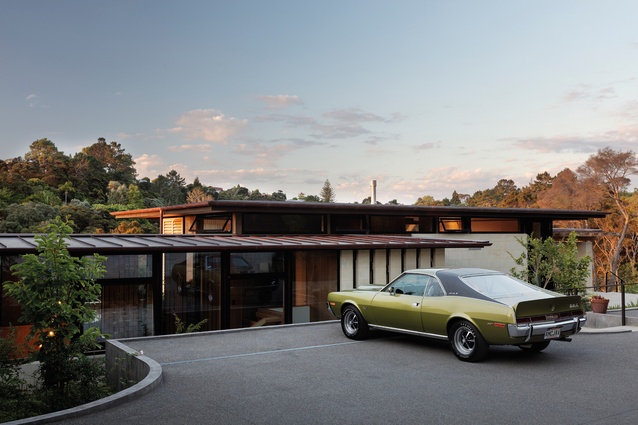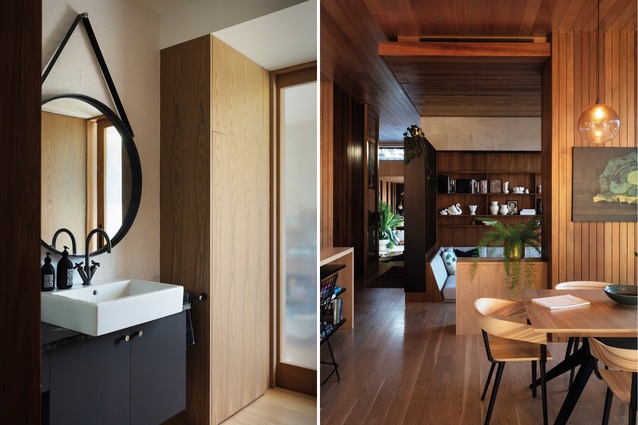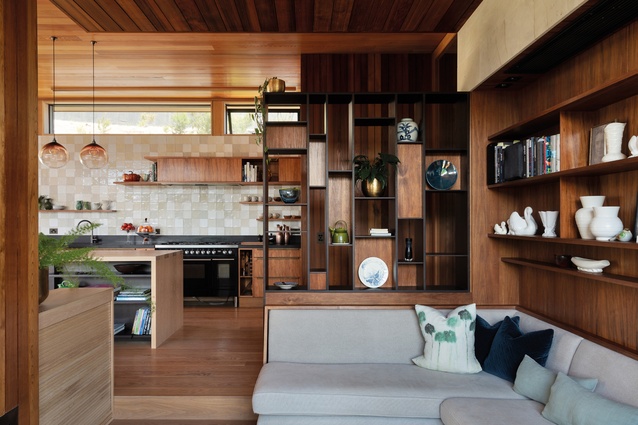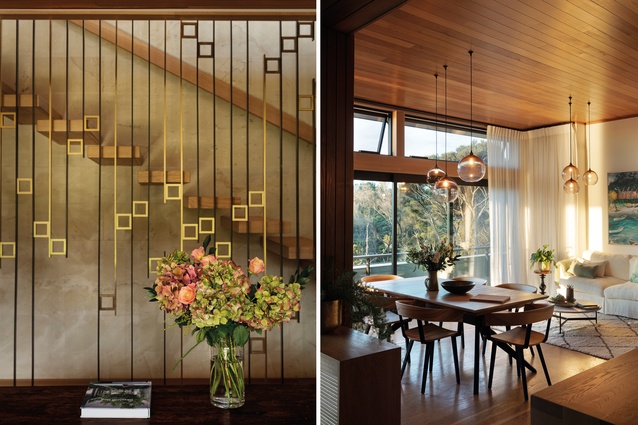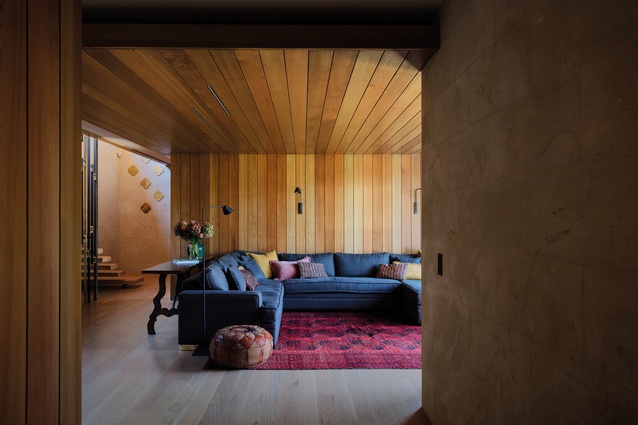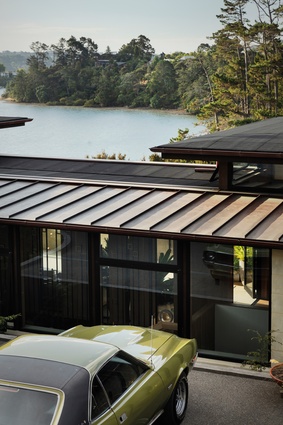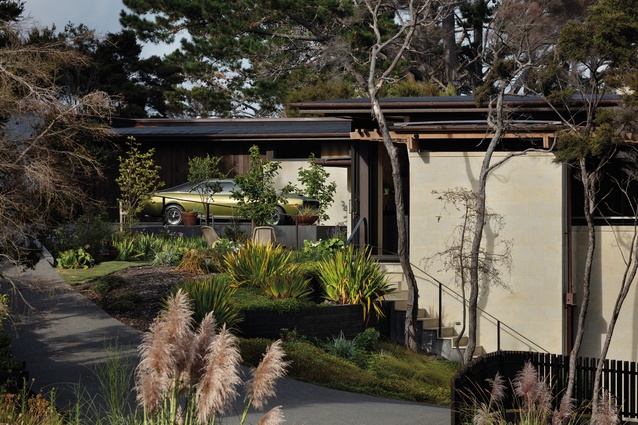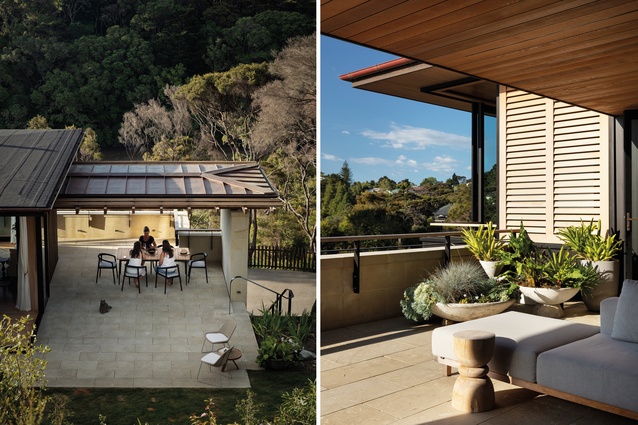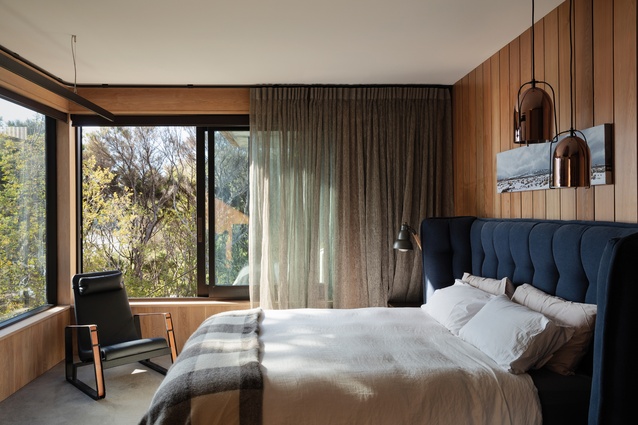Jewel on the hill: The Knoll
Inspired by iconic American architect Frank Lloyd Wright, this home on a hill of Auckland’s North Shore is steeped in family history and luscious detail.
There are many ways to describe this home that turns its back to the hum of traffic and its face to the sparkle of the Waitematā: a pavilion in the trees; an ornamented container for living; a generational jewel for the future. But the best way to understand it is to make the journey down the stairs from the curve of the driveway to the discreet front door, to rest your hand on the cool slab of bronze that is its handle, to pivot it open, and to stay silent but attentive as you wander through each room and take in the many hand-hewn elements that make this place as much art as architecture.
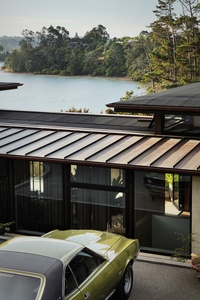
Owners Donald and Penny (they requested their first names be used) have a long history on this land. In 1947, when Donald’s grandfather, a city lawyer, bought some land in Greenhithe as a country escape, he had no inkling of how the North Shore would expand. He built a house on the highest point overlooking waters where once the thrum of the boat-building industry filled the valley and gumdiggers camped out on the banks of the two local creeks. He bought some more adjoining land in 1963 to grow grapes but, in 1970, the council requisitioned some of the land (and the house) to build the Upper Harbour Bridge and Highway.
Nevertheless, the rest of the property remained in the family and Donald remembers visiting his grandad on weekends when he was a very young lad. “We made the trip for Sunday dinner with all the cousins by taking the vehicle ferry from Wynyard Wharf to Birkenhead,” he says.
A love of this land, instilled when he was a child, endured. Fast-forward through the decades and Donald and his wife, Penny, bought the 14.5 acres that remained in his grandfather’s estate. There, they built their family home designed by Donald’s uncle, noted architect of the era Ray Thorpe.
It proved a magical place to bring up their four children. In 1992, they subdivided. “We had the vision of creating an enclave with no fences, shared facilities and responsibility for the common gardens, with houses that sat nicely in the land,” says Penny. They called the place The Knoll in a nod to Donald’s grandfather, who had called the land Knoll Knobbie.
When they asked architect Megan Edwards to design them a new home on the only section they hadn’t sold with stunning water views, they came armed with a detailed brief for the interior – much of it based on the work of Frank Lloyd Wright. “I particularly love his Usonian houses,” says Penny. “They were stunningly modern for their time but meant for middle-income people so a little less extravagant.”
But how do you translate the ideas of an American architect – and self-proclaimed genius – into the New Zealand context? Megan started with FLW 101: a house of the hill, rather than on the hill. “By digging into the site, we used the contours as a buffer against the motorway noise.” It also meant the house is set down, and grows from the landscape.
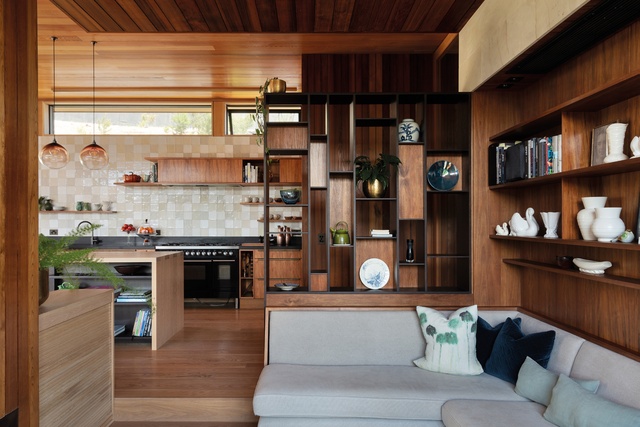
According to Megan, there is a simple geometry to the floor plan: “two rectangular, two-storeyed volumes connected by a stairwell and bridge.” These are pavilions, yes, but not as we have come to know them; it’s not the ultra-transparency of all-glass walls and a ‘see it at once’ design. Instead, on approach, elegant planes hover over the regenerating ma-nuka. “We used half-round copper spouting and cantilevered roofs to emphasise the horizontal lines,” says Megan. A substantial garage dissolves into the façade.
Shallow entry steps echo the low-slung linearity and vertical slots in the warm-toned Hinuera stone cladding give little away except perhaps… the keen of eye will notice metal detail-work on the slot windows – a hint of intricacies to come.
“The owners wanted a spacious home, with enough room to entertain and a bedroom each for their grown-up children to use on sleepover visits,” says Megan. But they are also collectors who admire well-made things – so, a modernist floor plan with a real “sense of interior” was the pathway.
On entry, the warmth of timber makes an immediate impression: the cedar tongue-and-groove ceiling and soffits, oil-finished American oak floors and joinery jambs, and Tasmanian blackwood cupboards in the kitchen. But the crafted cornucopia goes beyond the structure of a home beautifully put together by Quintin Orr and the team from Warren Adolph Homes.
There are built-in screens and shelving units, hand-drawn by Megan and painstakingly formed by cabinetmaker Neville Barnett. “Decorative elements have been layered into the building; we’ve drawn on the craftsmanship and talent of so many people to enliven the spaces.”
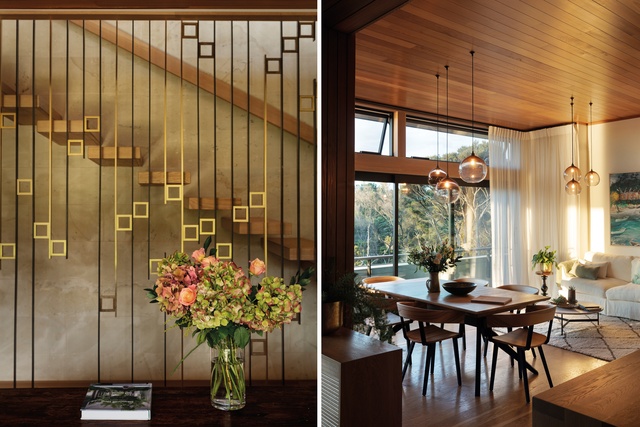
Mouth-blown glass orbs are sprinkled across the plan. On the stairwell of the bridge which links the master bedroom suite to the living pavilion, the show-stealer is a metal screen with vertical rods joined by brass ‘jewels’ like Klimt sequins.
In the kitchen, light glances off the splashback of handcrafted Portuguese tiles: an idea Megan gleaned from a visit to Rembrandt’s house in Amsterdam. When she showed Penny the shell-like variability of the cream-coloured tones of the tiles, they knew it fitted with the warmth, character and handmade nature of the rest of the home.
Such crafted intensity could be overwhelming but for the generous proportions of the built envelope; upstairs, in the main living zones, the stud is 3.2 metres. To the east and west, corners of the room have no supporting posts, continuous soffits and 1.2 metre overhangs so that there’s an incredible sense of the cantilever as the sides peel back to the terrace and garden.
To the north, a loggia provides a place to gather with the harbour as backdrop. “From there, we can look over to Herald Island, the Whenuapai airbase and Paremoremo,” says Donald.
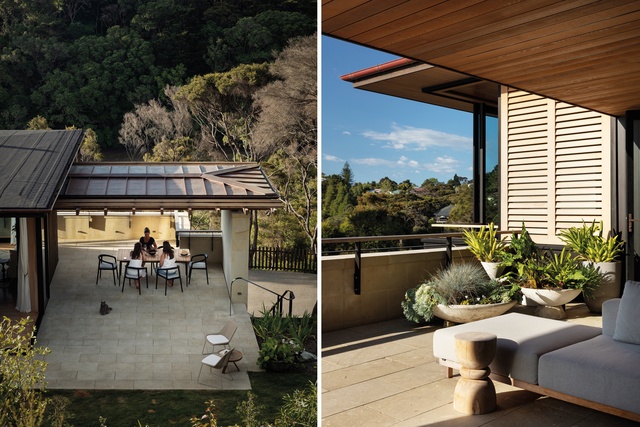
Located in a high-wind zone, the house is fully modelled for thermal performance with an insulated floor slab, low-e glazing and high-level opening windows to create a cooling ‘stack’ effect as warm air rises through the building. In summer, the home keeps it cool and, in winter, the snug comes into its own – a stepped-down space with a lowered ceiling and built-in bench seats with shelving behind, of which Frank himself would, no doubt, have approved.
In the mid-1990s, when Megan had recently graduated, a substantial renovation for Donald and Penny was her first real job. As her skills have grown so has the couple’s interest in architecture. It’s been a long-term, symbiotic relationship where challenges have been faced squarely.
It is not only a home, but character, that is built. “As time goes on, the house and the hill will continue to integrate,” says Megan. In the meantime, she is proud of their shared achievement. “I’m just happy they are both enjoying it.”
This article first appeared in Urbis magazine.


